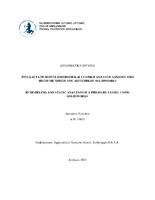| dc.contributor.advisor | Δημητρέλλου, Σωτηρία | |
| dc.contributor.author | Δεστούνη, Χριστίνα | |
| dc.date.accessioned | 2021-10-13T07:01:11Z | |
| dc.date.available | 2021-10-13T07:01:11Z | |
| dc.date.issued | 2021-10-07 | |
| dc.identifier.uri | https://polynoe.lib.uniwa.gr/xmlui/handle/11400/1324 | |
| dc.identifier.uri | http://dx.doi.org/10.26265/polynoe-1175 | |
| dc.description.abstract | Τα δοχεία υπό πίεση (pressure vessels) έχουν ως σκοπό να διατηρούν το αποθηκευμένο ρευστό
(υγρό ή αέριο) σε πίεση λειτουργίας υψηλότερη από την πίεση του περιβάλλοντος. Στο πρώτο
κεφάλαιο της διπλωματικής εργασίας γίνεται αναφορά στα βασικά χαρακτηριστικά των δοχείων
πίεσης, στους διεθνείς κανονισμούς και στις μεθόδους μη καταστρεπτικού ελέγχου. Στο δεύτερο
κεφάλαιο παρουσιάζονται αναλυτικά οι σχεδιαστικές αρχές που διέπουν τα δοχεία πίεσης
λεπτού τοιχώματος όπως η επιλογή υλικού και οι υπολογισμοί τάσεων και ελάχιστου
επιτρεπόμενου πάχους. Για τη θερμική και στατική ανάλυση μελετήθηκε ως ρευστό στο δοχείο
πίεσης η υγρή άνυδρη αμμωνία NH3. Οι βασικές ιδιότητες της αμμωνίας και οι κανονισμοί που
εφαρμόζονται για την αποθήκευσή της σε δοχεία πίεσης παρουσιάζονται στο τρίτο κεφάλαιο της
εργασίας. Στο τέταρτο κεφάλαιο περιγράφεται λεπτομερώς η τρισδιάστατη σχεδίαση δύο
μοντέλων κυλινδρικού οριζόντιου δοχείου πίεσης, με τη διαφορά τους να έγκειται στο τύπο των
κεφαλών, κυρτές (torispherical) και ημισφαιρικές (hemispherical) κεφαλές αντίστοιχα. Ο
σχεδιασμός έγινε λαμβάνοντας υπόψιν τις προδιαγραφές του κώδικα ASME BPVC Section VIII
– Division 1. Η θερμική και στατική ανάλυση των δύο μοντέλων πραγματοποιήθηκε στο
λογισμικό SolidWorks εφαρμόζοντας τα κατάλληλα θερμικά και στατικά φορτία και
παρουσιάζεται στο πέμπτο κεφάλαιο. Στο ίδιο κεφάλαιο αξιολογούνται τα αποτελέσματα και
προκύπτουν τα συμπεράσματα. | el |
| dc.format.extent | 101 | el |
| dc.language.iso | el | el |
| dc.publisher | Πανεπιστήμιο Δυτικής Αττικής | el |
| dc.rights | Αναφορά Δημιουργού - Μη Εμπορική Χρήση - Παρόμοια Διανομή 4.0 Διεθνές | * |
| dc.rights | Attribution-NonCommercial-NoDerivatives 4.0 Διεθνές | * |
| dc.rights | Attribution-NonCommercial-NoDerivatives 4.0 Διεθνές | * |
| dc.rights.uri | http://creativecommons.org/licenses/by-nc-nd/4.0/ | * |
| dc.subject | Solidworks | el |
| dc.subject | Δοχείο υπό πίεση | el |
| dc.subject | Τρισδιάστατη μοντελοποίηση | el |
| dc.subject | Pressure vessel | el |
| dc.subject | 3D modeling | el |
| dc.subject | Αμμωνία | el |
| dc.title | Τρισδιάστατη μοντελοποίηση και στατική ανάλυση δοχείου υπό πίεση με χρήση του λογισμικού Solidworks | el |
| dc.title.alternative | 3D Modeling and static analysis of a pressure vessel using Solidworks | el |
| dc.type | Διπλωματική εργασία | el |
| dc.contributor.committee | Pagonis, Dimitris Nikos | |
| dc.contributor.committee | Λιβανός, Γεώργιος | |
| dc.contributor.faculty | Σχολή Μηχανικών | el |
| dc.contributor.department | Τμήμα Ναυπηγών Μηχανικών | el |
| dc.description.abstracttranslated | Pressure vessels are intended to keep the stored fluid (liquid or gas) at an operating pressure
higher than the ambient pressure. The first chapter of the thesis refers to the basic characteristics
of pressure vessels, international regulations, and non-destructive control methods. The second
chapter presents in detail the design principles that govern thin-walled pressure vessels such as
material selection and calculations of stress and thickness. Liquid anhydrous ammonia NH3 was
used as the fluid for thermal and static analysis. The basic properties of ammonia and the
regulations applicable to its storage in pressure vessels are presented in the third chapter of the
thesis. The fourth chapter describes in detail the three-dimensional design of two cylindrical
horizontal pressure vessel models, with difference in the type of heads, torispherical and
hemispherical respectively. The design was based on the specifications of the ASME BPVC code
Section VIII - Division 1. The thermal and static analysis of the two models in SolidWorks,
applying the appropriate thermal and static loads, is presented in the fifth chapter. In the same
chapter the results are evaluated, and the conclusions are drawn. | el |


